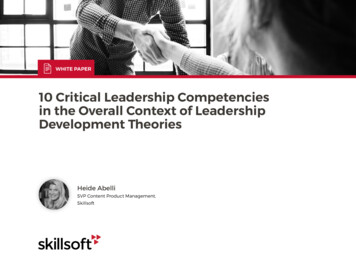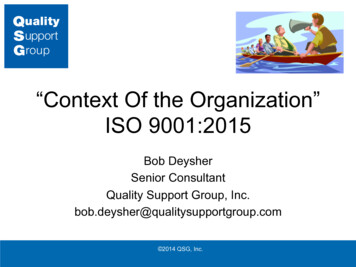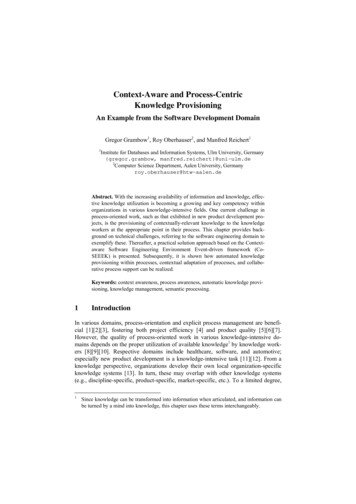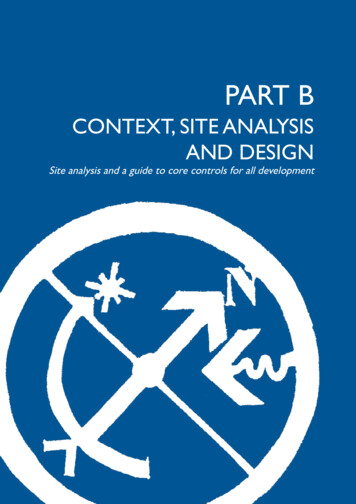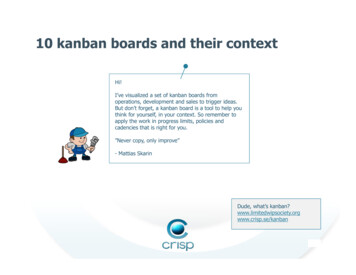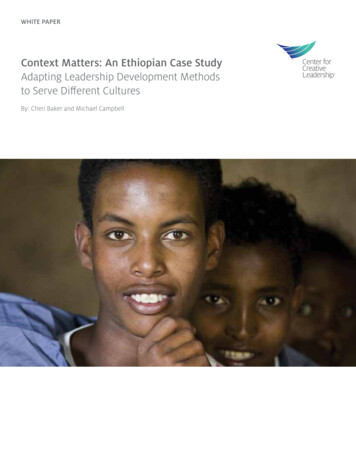
Transcription
WHITE PAPERContext Matters: An Ethiopian Case StudyAdapting Leadership Development Methodsto Serve Different CulturesBy: Cheri Baker and Michael Campbell
ContentsExecutive Summary1Introduction3Lesson 1: Build Cross-Cultural Competence4Individualism and Collectivism5Low-Context vs. High-Context Cultures7Power Distance8Lesson 2: Understand the Local Context10Examples from the Field11The Bubblegum Machine11The Social Identity Map13Conclusion17References and Further Reading18About the Authors19Appendix20
Executive SummaryLeadership Beyond Boundaries (LBB) is aninitiative of the Center for Creative Leadership(CCL ) that strives to unlock human potentialthrough international leadership development.Building upon decades of knowledge from CCL’sresearch and training practices, LBB’s missionis to make high-quality leadership developmentinclusive, accessible, scalable, and affordableto people worldwide. LBB accomplishes thisby creating low-cost leadership developmentprograms, tools, and models that are used byinternational nongovernmental organizations(NGOs), community organizations, governmentagencies, and educational institutionsworldwide. By democratizing access toleadership training, LBB empowers people toforge a new social contract—one that honorspersonal well-being, appreciates diversity,respects non-Western thought patterns, andvalues social connectivity and contribution inaddressing complex global issues.A key challenge faced by the LBB team has beento design and deliver leadership developmenttools and activities, created primarily for leadersin a Western context, to use with leadersoperating in non-Western contexts. In otherwords, how do we develop and adapt bestpractice leadership development techniques toserve diverse leaders? This white paper sharessome of the lessons learned from the LBBinitiative on how to effectively contextualizeleadership development practices for those wholead in non-Western cultures.In this paper, we elaborate on ways tocontextualize leadership development toolsand practices for an African audience, focusingspecifically on a case study of LBB work withhealthcare leaders working in remote areas ofwestern Ethiopia. When leadership developmentreflects the local cultural dynamics, followers aremore apt to recognize their leaders as credible.By reinforcing our knowledge of cross-culturalcommunication, CCL’s Leadership BeyondBoundaries initiative will continue to reframeleadership to include the specific dynamics,behaviors, and cultural imperatives of Africanleadership. 2016 Center for Creative Leadership. All rights reserved.1
Lesson 1Build Cross-Cultural CompetenceUsing existing research on cultural differences, we demonstrate how to raise the awareness of thoseimplementing leadership development trainings in non-Western cultures. We will share how having abroader understanding of cultural dimensions impacted CCL’s work with Ethiopian leaders.Lesson 2Understand the Local ContextWe describe how working with local partners, conducting focus groups, and creating prototypes aids inthe process of contextualizing leadership development tools and approaches.Examples from the FieldFinally, we present how two leadership developmenttools and methods were “contextualized” to meet theneeds of local leaders.2 2016 Center for Creative Leadership. All rights reserved.
IntroductionAs the need for leadership talent increases due tothe economic growth of emerging, non-Westerneconomies (for example the BRICS economies ofBrazil, Russia, India, China, and South Africa), theneed for leadership development solutions in theseparts of the world has also increased. Inherent inthis expansion of leadership development serviceshas been the challenge of applying mostly Westernviews of leadership and leadership training tonon-Western cultures. As a provider of leadershipdevelopment solutions, CCL has experienced howcontext matters firsthand, both through our workwith business, government, and non-governmentleaders as well as our Leadership BeyondBoundaries work with populations that havegenerally been underserved when it comesto leadership development training.So what do we mean by context? Contextrefers to the fundamental differences thatexist among people around the world. Thesedifferences influence leadership style, behavior,and understanding. As leadership developmentpractitioners with our own set of cultural lenses,values, and beliefs, we must develop a localizedunderstanding of how to teach interpersonal andorganizational leadership development in culturesdifferent from our own. We must focus not onlyon how the cultures we are training are differentfrom our own, but on what those differences tell usabout our approach to leadership development.One of the central challenges facing leadershipdevelopment professionals working in differentcultures is how to contextualize leadershipdevelopment tools. We must determine whatcultural context tells us about what tools andmethods to use, and how to use them.CCL’s Leadership Beyond Boundaries team hasbeen contextualizing leadership development toolsand teaching methods within the African culturalcontext in Ethiopia and across the continent since2006. Through this work, we have recognized theimportance of both teaching and training from thelocal perspective and the implications of eitherconsciously or unconsciously imposing Westernvalues of leadership. Ignoring these culturaldifferences in leadership styles, behaviors, andvalues is detrimental to developing African leaders.By understanding, acknowledging, embracing,and including the values inherent in Ethiopian andother African leadership styles (or more broadly aswe work with women, children, NGO staff, ministryofficials, and health officials), we increase thelikelihood that leadership development will have ameaningful impact on these populations.The lessons CCL has learned by contextualizingleadership development can aid the efforts of otherpractitioners looking to develop leaders in culturesand contexts very different from their own. 2016 Center for Creative Leadership. All rights reserved.3
Lesson 1Build Cross-Cultural CompetenceFundamental to the challenge of contextualizingleadership development is understanding cultureat a societal level. Like leadership, there are manydefinitions of culture. Scholars, anthropologists,sociologists, and psychologists have contributedmore than 300 definitions, all highlighting differentaspects of the concept. For the purposes of thiswhite paper, consider this working definition ofculture: a complex, multidimensional, sharedreality that is transmitted over generations. Thesedynamic, collectively held attributes, behavioralpatterns, values, traditions, communication rules,thinking and learning styles, and relationshiptypes reveal how and why individuals think, act,and feel. Think of culture like the air we breathe.It is all around us, yet it is often invisible. Weexperience culture almost unconsciously. Hereinlies the challenge for most Western leadershipdevelopment practitioners. Those who designand deliver leadership development experiencesfrequently come from a very different culture thanthose who actually go through the experience.Training methods are often designed with anunconscious bias toward the practitioner’s culture,not the culture of the leaders being developed.Thus, lesson one for contextualizing leadershipdevelopment approaches is to build the crosscultural competence of practitioners.4 2016 Center for Creative Leadership. All rights reserved.Cross-cultural competence refers to “the abilityto effectively communicate and interact in othercultures. Cultural empathy, communication skills,the ability to form and maintain relationships,the ability to be patient, flexible, and adaptableto culturally diverse situations are among themost important competencies in determiningcross-cultural effectiveness” (Tavanti, 2005).Cross-cultural competence is crucial in developinginternational leaders.In the course of CCL’s leadership developmentwork with Ethiopian leaders, the LeadershipBeyond Boundaries team built cross-culturalcompetence by examining the work of notedcultural scholars (Geert Hofstede and E. T. Hall) tounderstand how the Western US culture comparesto the Ethiopian culture on three different culturaldimensions: Individualism vs. Collectivism, LowContext vs. High-Context, and Power Distance. Wedescribe each briefly and offer examples of howthese cultural dimensions played out in CCL’s workwith Ethiopian leaders. For more information oneach cultural dimension, please see Appendix.
Individualism vs. CollectivismThe cultural dimension referred to asIndividualism vs. Collectivism concerns whetherleaders see themselves more as individuals ormore as group members. Many African cultures,including that of Ethiopia, are highly collectivist.Collectivist cultures focus on relationships,group obligation, and interpersonal harmony.Many Western cultures, in particular the UnitedStates, are highly individualist. Individualistcultures focus on self-interest, self-expression,and the uniqueness of every person.Individualist cultures often operate from beliefsand values where it is more natural to place theself before the team. Leadership developmentin these cultures tends to focus on what comesless naturally: the importance of teams andteamwork. However, since leaders in collectivistcultures operate from beliefs and values thattend toward groupthink and group before self,leadership development stresses what comesless naturally: original thought, problem solving,and critical thinking.One way CCL was able to contextualizeleadership development for a more collectivistculture like Ethiopia was to reframe experientialexercises around one of the most importantcollectives to Ethiopian leaders: the family. 2016 Center for Creative Leadership. All rights reserved.5
A team-building activity often used in Western leadership development is thehelium stick (See below: The Helium Stick Activity). This activity has a simple setupand usually does not require a back story or scenario as part of that setup. Becausestories and connections to family and other relationships are important to collectivistcultures, we tested a number of stories in a series of focus groups that would relateto the local context. These focus groups all agreed on a contextualized story abouta food and supply drop during a medical emergency in the Gambella Region thatwould save the affected communities from an outbreak of disease. In this story, thehelium stick represented all the life-saving food and medical supplies that needed toreach the ground safely to help save the local population. When a facilitator used thisstoryline during a focus group, the situation became so real for the participants thatan Ethiopian leader’s very serious reaction within the activity was: “We have to do abetter job! I don’t want my family to be sick!”This is one simple example of how cross-cultural competence can be used tocontextualize a leadership development activity.The Helium Stick ActivityThe rules are simple. Organize into smallgroups of eight to ten people. Take a verythin dowel rod or hoop (the thinner thebetter), and hold it horizontally aboutchest height. Ask the participants to holdthe stick or hoop on top of their indexfingers, and lower it to the ground as ateam. Once the teams begin to touch thestick or hoop, the challenge will presentitself quickly. The stick/hoop is so lightthat the up-force from each of the fingerstrying to stay in contact is greater thanthe weight of the stick/hoop. The result?Immediately, the stick/hoop will begin torise even though they are trying to lowerit to the ground as a -game-helium-stick/).6 2016 Center for Creative Leadership. All rights reserved.
Low-Context vs. High-Context CulturesEdward T. Hall is best known for his work in developing the ideas of low- and high-context cultures. Forleadership development practitioners, knowing whether you’re designing and delivering training in alow- or high-context culture has a significant impact on the ways in which leaders communicate. Leadersfrom the United States, which is a low-context culture, tend to be more direct, explicit, and structured intheir communication, particularly in verbal messages. Leaders in high-context cultures, such as Ethiopia,tend to communicate more implicitly, using more nonverbal communication and expressing more vagueverbal messages (at least from the viewpoint of a low-context culture).A few relevant examples of differences in communication between low- and high-context cultures arefound in Table 1.Table 1: Descriptions of Low- and High-Context CulturesLow-ContextHigh-ContextValue direct verbal interaction andare less able to read nonverbalexpressions; focus on words.Value indirect verbal interaction andare more able to read nonverbalexpressions; focus on behavior.Speaker-oriented style.Listener-oriented style.Saying “no” is completelyacceptable and appreciated.Impolite to say “no”to a request.Rely on precise facts, statistics,and supporting details.Often rely on intuition or trust ratherthan facts.Table 1: An Africa-specific adaptation of the table in Foundations of Intercultural Communication, Chen & Starosta (2005).When one of the authors went with an Ethiopiancolleague to the Gambella Region to help launchthe USAID World Learning program grant todevelop the leadership skills of the healthcareworkforce, the innate differences in low- versushigh-context cultures became apparent. Inmeetings with regional government officials,the author tended to want a definitive “yes” toall requests for help, compliance, and support.(Remember that the US is a low-context culture.)The Ethiopians in the region would say “ok”or “maybe” in response to requests, but theyrarely if ever said “yes” or “definitely.” After aweek of meetings with seemingly unansweredquestions the author began to understand that theEthiopians’ ambiguity towards answering requestsdefinitively was not a lack of commitment to theprogram. Instead, the behavior displayed by theEthiopian officials meant that harmony in theirlives was so valued that they were not willingto let CCL down by promising something theycould not guarantee. (Remember that Ethiopia isa high-context culture.) In reality the Ethiopiangovernment officials did everything that wasrequested of them and more; they just would notofficially say “yes” to these requests.Leadership development practitioners from lowcontext cultures should understand and appreciatehow their communication style differs in highcontext cultures. Western ideals and lessonsabout open communication and being directmay not apply or resonate with leaders fromhigh-context cultures. 2016 Center for Creative Leadership. All rights reserved.7
Power DistanceThe term power distance refers to the extent to which less powerfulmembers of institutions and organizations within a country expect andaccept that power is distributed unequally (Hofstede, Hosfstede, &Minkov, 2010). Said another way from a leadership perspective, culturesdiffer on what is acceptable interpersonal behavior between subordinatesand superiors when it comes to influencing, communicating, andchallenging authority. A high power-distance culture accepts inequalitiesof power and status, while lower power-distance cultures tend to stressequality in decision-making and opportunity regardless of status. Thiscultural dimension is often thought of as a continuum from hierarchy(high power distance) to equality (low power distance).Table 2: Descriptions of Low and High Power-Distance CulturesLow Power DistanceHigh Power DistanceSubordinates expect to be consulted.Subordinates expect to be told what to do.Privileges and status symbols arefrowned upon.Privileges and status symbols expected.Teachers expect class participationand individual achievement.Teachers are expected to teach and not callon students.Inequalities between people shouldbe minimized.Inequalities between people are expected.Table 2: Power-distance culture descriptions by Hofstede, Hofstede & Minkov (2010).8 2016 Center for Creative Leadership. All rights reserved.
An example from CCL’s work in Ethiopia(Ethiopia is a high power-distance culture.) isthat employees rarely feel comfortable askingquestions of their superiors. If a superior tells anemployee what tasks to complete, that employeeis expected to do them. The employee wouldrather do it wrong than ask for clarification fromhis or her boss because asking for clarificationcan be seen as insubordination. The culturaldimension of power distance may also explainwhy many Ethiopians feel uncomfortable whenmixing with employees of a different statusand why promoting bright, young, independentemployees is problematic. Employees are expectedto fall in line, not to share their ideas, and notto seek advancement. Employees accept ratherthan challenge the ideas of their more powerfulsuperiors.When using an experiential activity in leadershipdevelopment training, facilitators commonlyencourage leaders to openly share their ideas andto influence others toward a desired direction.While promoting the expression of individualideas may prove to be an important learning pointin a training activity, leadership developmentpractitioners should be aware how that samebehavior back at work could be detrimental tothe leader and may increase the risk of the leaderbeing labeled a troublemaker. The real valueof an experiential exercise is helping leadersrecognize the significance of a concept andhow to apply it back at work. Therefore, whentraining leaders about the value of individualthinking, influencing, and problem-solving,leadership development practitioners shouldfacilitate conversations about how these lessonscan be applied safely and appropriately back in thework environment.Building cross-cultural competence through anunderstanding of power distance in a culture willhelp leadership development practitioners makebetter connections between the training and theback-at-home experience of the leader.The Bottom Line for Lesson 1: Build Cross-Cultural CompetenceThere is a wealth of research available to leadership development practitioners tohelp them have a greater understanding of how cultures may differ and operate underfundamentally different core beliefs and values. Having a broader understanding ofcultural dimensions was an important lesson for contextualizing Western leadershipdevelopment tools for a non-Western culture. 2016 Center for Creative Leadership. All rights reserved.9
Lesson 2Understand the Local ContextIf Lesson 1 (build cross-cultural competence) isimportant for a macro-understanding of culturaluniqueness, Lesson 2 takes contextualization ofleadership development to the micro (or local)level. For CCL’s work in and around east Africa,an analysis of differences in local contexts andcultures was critical in contextualizing leadershipdevelopment for local leaders. In order tounderstand the local context in Ethiopia, CCLpartnered with local stakeholders and conductedfocus groups with local leaders, facilitators, andpractitioners.After applying for and receiving a USAID-fundedWorld Learning program grant (for 2011-2012) todevelop the leadership capacity of the healthcareworkforce in a marginalized region in westernmostEthiopia, CCL’s Leadership Beyond Boundariesteam took the initiative to conduct a series of focusgroups to further facilitate our understanding ofEthiopian leadership styles and patterns. Two focusgroups, which included approximately 23 localparticipants, were conducted over five days. (Mostparticipants were males [87%], students [83%],and with an average age of 21.5 years.) The focusgroups were part of an overall effort to create aninnovative Team-In-A-Box Toolkit to help remote,newly trained facilitators teach leadership skillsthrough experiential learning activities.10 2016 Center for C
to people worldwide. LBB accomplishes this by creating low-cost leadership development programs, tools, and models that are used by international nongovernmental organizations (NGOs), community organizations, government agencies, and educational institutions worldwide. By democratiz


